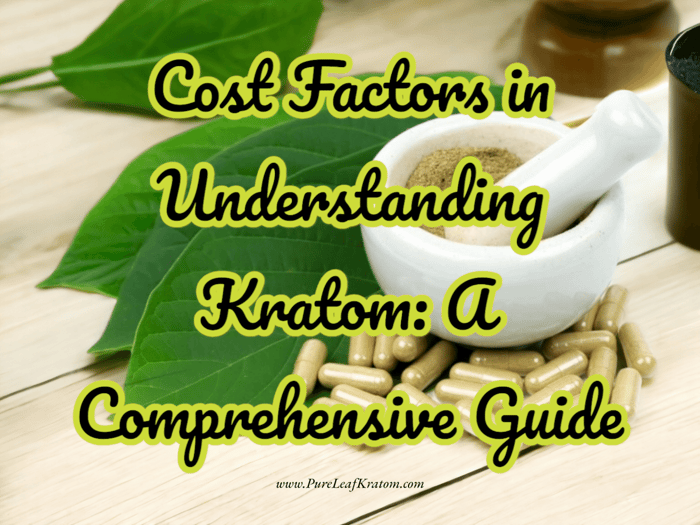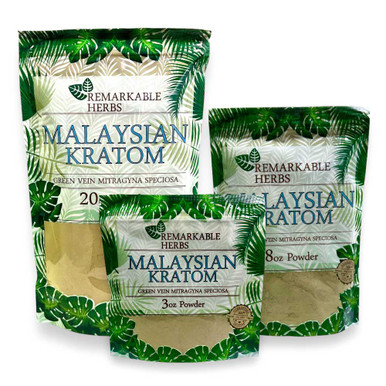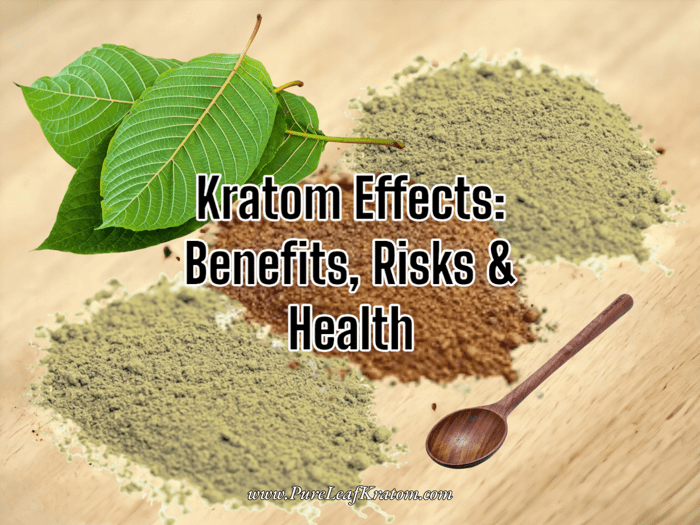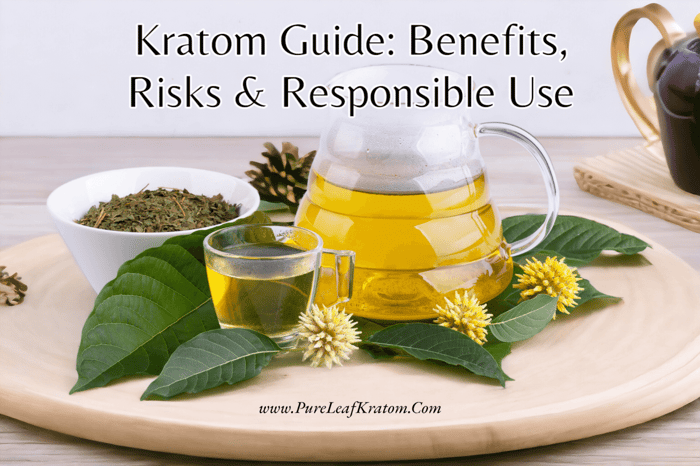
Unraveling the Price Tag: A Comprehensive Guide to Kratom Cost Factors
Introduction to Kratom
Originating in Southeast Asia, Kratom (Mitragyna speciosa) has become a global health phenomenon. Whether you're a consumer or retailer, understanding the intricate world of Kratom prices can be challenging. Explore its rich history, uses, and the associated cost.
Understanding Kratom: A Scientific Snapshot
Kratom is an herbal extract derived from a large tree native to Southeast Asia. Its scientific classification falls under the coffee family, Rubiaceae. Known for its dark green leaves, Kratom has been a staple in traditional medicine in its native regions for centuries. The plant's unique alkaloid profile, featuring compounds like mitragynine and 7-hydroxymitragynine, contributes to its varied therapeutic properties.
Origin and Traditional Usage of Kratom
Rooted in the lush tropics of Southeast Asia, particularly Thailand, Malaysia, and Indonesia, Kratom has been used as a traditional medicine for generations. Initially, local communities chewed its leaves or brewed them into tea to combat fatigue, alleviate pain, and even manage opioid withdrawal symptoms, attesting to Kratom's potent properties.
Kratom's Voyage to the Western World
The last few decades witnessed Kratom's popularity spreading to Western regions like Europe and North America. As the interest in natural and herbal remedies heightened, so too did curiosity in this seemingly potent plant. Despite its association with controversies and legal ambiguities, Kratom's acclaim in alleviating chronic pain and supporting mental wellness continued to pique international interest.
Legality of Kratom: An Overview
The legal status of Kratom varies widely across the globe. In its native realm, it is often heavily regulated, with countries like Thailand only recently lifting a seven-decades-long ban. In contrast, it remains legal in most parts of the United States, subject to state-level restrictions. However, the absence of FDA approval for its medicinal use and the potential risks of misuse make Kratom a product that needs to be handled with knowledge and discretion.
Common Uses of Kratom: A Balance of Benefits and Risks
The potential benefits attributed to Kratom range from pain relief, mood enhancement, to energy boosting properties, largely attributable to its unique alkaloid composition. However, it's imperative to balance this with an understanding of possible risks, which include dependency, withdrawal symptoms, and potential adverse reactions when consumed in high doses or combined with other substances.
Kratom, a tropical evergreen tree native to Southeast Asia, is renowned for its immense therapeutic potential. Consumers are presented with various forms of Kratom to choose from, each with its unique properties, uses, and corresponding price tags.
Krave Kratom Capsules Red Dragon

$9.89
Krave Kratom Capsules Red Dragon Red Dragon Kratom is a matured strain packed with pure potency. Krave Kratom Capsules Red Dragon offers Kratom consumers a pristine...… read more
Kratom in Capsule Form
Capsule form is a widely-preferred method of Kratom consumption due to its convenience. Kratom is first ground to a powder and then encapsulated within a small, usually gelatin or vegan, capsule. This form allows easy ingestion, control over dosage, and masks the bitter taste.
Description and Method of Preparation
Kratom capsules are prepared with a precise amount of Kratom powder, typically ranging from 500 mg to 1 gram per capsule. The powder is placed in a specialized machine capable of filling the capsules uniformly.
Usage and Potential Benefit
Kratom capsules are used widely for their potential benefits such as pain relief, mood enhancement, and boosting energy levels. The encapsulation process potentially protects the alkaloids present in Kratom from degradation, thus, maintaining its efficacy.
Kratom in Powder Form
Raw Kratom leaves are dried and crushed or ground to a fine powder. Kratom powder is arguably the most common form, offering flexibility regarding preparation and usage. Users can ingest it directly or mix it with food and beverages.
Description and Preparation
Kratom powder is made from dried Kratom leaves ground to varying degrees of fineness. The powder can be portioned according to user preference, with an average dosage around 2-3 grams per serving.
Usage and Potential Benefits
Homebrew teas, topical pastes, and dietary incorporation are some of the common uses of Kratom powder. Some associate its use with stress relief, anxiety reduction, and the promotion of better sleep.
Other Forms of Kratom
While capsules and powder constitute popular choices, Kratom is also available as dried leaves and extracts. The dried leaves can be brewed as a tea, while the extracts are concentrated forms derived from the leaves.
Description and Usage
Dried leaves are usually steeped in hot water to make Kratom tea, providing the benefits of the plant in a soothing drink. Kratom extracts are preferable for those seeking a higher potency. This concentrated version of Kratom is priced higher due to the intensive extraction process.
Understanding the price of Kratom involves examining a variety of factors, all of which play a role in determining its cost on the market. It's important to be aware of how each particular aspect influences the final price you pay when purchasing this potential herbal remedy, whether as capsule, powder, or any other form.
Remarkable Herbs Kratom Powder Green Malaysian

$23.95
Remarkable Herbs Green Malaysian Kratom Powder Introducing the superstar of the kratom world - Remarkable Herbs Green Vein Malaysian Kratom Powder. Whether you're a kratom...… read more
Costs of Cultivation: Labor, Land, and Climate Considerations
Like any other farm-grown product, the cost of cultivating Kratom significantly contributes to its final pricing. This encompassed labor, land, and climate considerations. Labour-intensive cultivation requires a substantial number of workers to plant, care for, and harvest the leaves, which adds to the final cost. The cost of leasing or owning land, especially fertile land that supports the growth of healthy Kratom trees, can also add to the total cultivation costs. Lastly, the climate plays a crucial role. Kratom thrives in tropical climates, and any unsuitable climate conditions can lead to poor crop yields, increasing the price.
Processing and Refinement Costs
Post-harvest, Kratom leaves undergo a series of processes such as drying, refining, and grinding into powder. These processes require time, effort, and equipment, which directly affect the cost of the final product. For more robust variations like ultra-enhanced Kratom or extracts, additional refining steps are necessary, making the product even more expensive.
Vendor Pricing: Markup and Overhead Costs
The practices adopted by vendors also play a significant role in Kratom pricing. Most vendors account for their overhead costs, risks, and desired profit when deciding the retail price of Kratom. Though the markup varies amongst vendors, it is a sober reminder that the final cost includes more than just the product's basic production cost. Price per gram also varies depending on vendor pricing.
Import Costs: Taxes, Transport, and Custom Duties
Kratom primarily originates from Southeast Asian countries like Thailand and Indonesia. As such, import costs including shipping, customs duties, and taxes, can considerably increase its price, especially for individual buyers when compared to bulk purchases. The bulk pricing is generally lower on a per gram basis, due to economies of scale on shipping and customs duties.
Impact of Legal Restrictions on Price
The legal status of Kratom highly influences its pricing. In regions where it is outright banned or heavily regulated, the related risk and legal restrictions can potentially drive up its cost. Any legal changes can cause price changes as vendors may adjust their prices based on the legal status of Kratom in different jurisdictions. It is essential to keep track of the current legal statuses and adjust your expectations accordingly.
Kratom Prices: A Domestic vs International Comparison
The cost of Kratom varies between the prices of locally grown products and imported goods. Distinct factors such as the degree of industrialization, labor costs, and agriculture practices can greatly affect the prices across different regions.
Cost of Locally Grown Kratom
Domestically grown Kratom tends to have a lower price due to a few specific factors. The absence of import taxes and reduced transportation costs can have a significant impact on the price of kratom, making domestically grown varieties more affordable.
Factors Affecting Prices
Local varieties can suffer from pricing volatility as raising Kratom domestically is dependent on specific growing conditions. Factors like climate, fertility of the soil, and the quality of the matured leaves can greatly affect the effort required to cultivate the plant, which in turn, affects the price per gram.
Regional Price Variations
Regional differences can further influence the domestic prices of Kratom. Areas with ideal growing conditions can produce a higher yield, subsequently driving down costs, while areas requiring additional resources to foster growth will have higher prices.
Cost of Imported Kratom
On the other hand, imported Kratom often comes with high costs due to several factors.
Import Sources and their Pricing
Most of the Kratom sold in the United States and Europe is imported from Indonesia, mainly because it's one of the world's largest producers of the herb. Indonesian farmers benefit from the country's rich vegetation and ideal climate conditions, leading to relatively low vendor prices. However, the additional costs of import taxes, duties, and transport to individual countries, increase the final retail price.
Impact of Distance and Shipping on the Price
Usually, the farther the product needs to travel, the higher its shipping costs. Apart from these, other elements such as delays in clearance, additional custom fees, and quarantine restrictions also amplify the wholesale pricing of imported Kratom, leading to variable bulk pricing across countries.
Club 13 Kratom Extract Gummies Variety Pack Squares

$20.89
Club 13 Kratom Extract Gummies Variety Pack Squares Introducing our Club 13 Kratom Extract Gummies Variety Pack Squares, a delightful and convenient way to incorporate...… read more
Wholesale vs Retail Pricing: An In-depth Analysis
Understanding the finer details of wholesale and retail pricing structures can help consumers make more informed decisions when buying Kratom.
Basics of Wholesale Pricing
Wholesale pricing involves a cost-selling setting where products are sold in large quantities to retailers or directly to end consumers. The advantage of wholesale pricing is that it offers a lower cost per gram or per unit, due to economies of scale. This means the unit price is reduced as the volume bought increases. However, the potential downside is the storage costs. After purchasing in bulk, the buyer must have adequare space to store the product. Kratom storage also requires specific conditions such as a cool, dark, and dry place to maintain product quality. Wholesale pricing remains a preferential alternative for long-term and heavy users of Kratom who can take advantage of the price breaks with large volumes.
Basics of Retail Pricing
Retail pricing, on the other hand, involves selling Kratom to customers in smaller quantities. Retailers mark up the price to cover operating costs, affecting the retail overhead, and taxes that need to be remitted to the government. Retailers also need to set prices high enough to realize a profit. The markup can considerably affect the final price of the Kratom at the retail level.
Comparative Analysis: Price, Quantity, Benefits
When comparing the two pricing structures, both have their unique benefits. Wholesale purchasing is advantageous if quantity and long-term usage are the primary focus. In terms of price, bulk pricing can help in significant savings as long as the user has the means to store and preserve Kratom, while retail pricing caters to the casual user who may not need large amounts of Kratom at once. Retail pricing allows for more flexibility and less upfront cost, but the prices per unit will likely be higher when compared to wholesale. Therefore, the choice between these two entirely depends on the individual's consumption needs.
VI. Kratom Pricing: A Trip Through Time and Current Trends
The price of Kratom, just like any other commodity, is influenced by various historical, current, and projected market trends. By understanding these trends, buyers can make informed decisions and better predict future pricing scenarios.
A. Review of Historical Pricing
Historically, Kratom prices have significantly evolved due to various factors such as inflation, demand, supply, and legal regulations. For instance, as per the law of demand, when the demand for Kratom increased due to its growing recognition in health and wellness circles, prices also increased. In contrast, enhanced supply, often linked to increased cultivation, has led to price drops at certain periods.
In addition, inflation has subtly shaped the price per gram of Kratum over time. As with any product, Kratom has not been spared the effects of inflation, leading to gradual price increases over an extended period. Furthermore, legal changes, such as unanticipated bans or sudden regulation changes, have also instigated temporary price surges due to the unexpected restriction of availability.
B. Recent Pricing Trends
More recently, Kratom costs have been primarily influenced by its rising global popularity, resulting in increased demand. Capsule pricing, powder pricing, and even bulk pricing have all seen adjustments as a result. Additionally, as vendors strive to compete in an increasingly crowded market, divergences in vendor prices have emerged based on factors such as quality assurance, product differentiation, and customer service. Global factors, including import prices and domestic prices, continue to play a significant role in overall pricing trends as well.
Simultaneously, the expansion of online shopping platforms and a rise in digital payment options have also facilitated easier access to the product, both in wholesale and retail formats, hence expanding its market reach and impacting pricing trends.
C. Future Price Projections
Moving forward, Kratom price trends will likely continue to evolve, influenced by factors such as increased market regulation, changing cultivation patterns, and fluctuations in demand, among others. As more clinical research and studies on Kratom’s health benefits emerge, popularity and subsequent demand might increase, which could translate into upward price trends.
Conversely, decisions to grow more Kratom to meet this increasing demand, alongside improved cultivation processes and agricultural technologies, could lead to increased supply and potential price stabilization in the long run. All these factors should be considered in cost breakdown, financial considerations, and budgeting for Kratom.
Thus, while anticipating future price trends, buyers should stay informed about shifting market dynamics, legal stipulations, and emerging cultivation practices to make sound financial and wellness decisions regarding Kratom purchases.
When incorporating Kratom into your lifestyle, financial considerations can play a significant role. Balancing your desired use against the costs is crucial for long-term, sustainable consumption. This requires understanding the price structure of Kratom, including the price per gram, bulk pricing, and cost considerations involved in different purchase quantities.
Key Factors to Consider while Budgeting for Kratom
As you budget for Kratom, remember that price is not the sole factor to consider. Quality, vendor credibility, and personal usage patterns should also influence your decisions. Kratom with a higher price per gram might promise a superior quality. Sourcing your product from a trustworthy vendor can protect against substandard products or unfair pricing practices. Furthermore, your usage pattern – casual or daily – should guide your purchase quantity.
Understanding Value for Money: Price Per Gram
The price per gram can greatly influence your perception of the product's value. When comparing different vendor prices, ensure to compare prices per gram for a uniform evaluation. Although a larger package might have a higher initial price, the price per gram can be significantly lower, offering better value for money. Assess the price per gram alongside quality indicators, such as potency and purity, to make an informed purchase decision.
Bulk Pricing vs Small Quantity Pricing: Pros and Cons
Bulk pricing and small quantity pricing offer unique advantages. If you're a frequent user, bulk pricing can be cost-effective, reducing the price per gram and offering longer shelf-life value. However, this requires a larger upfront payment and storage considerations. Small quantity pricing, popular in retail pricing, may offer flexibility for casual users or those wanting to experiment with different strains. Yet, this typically comes at a higher price per gram.




